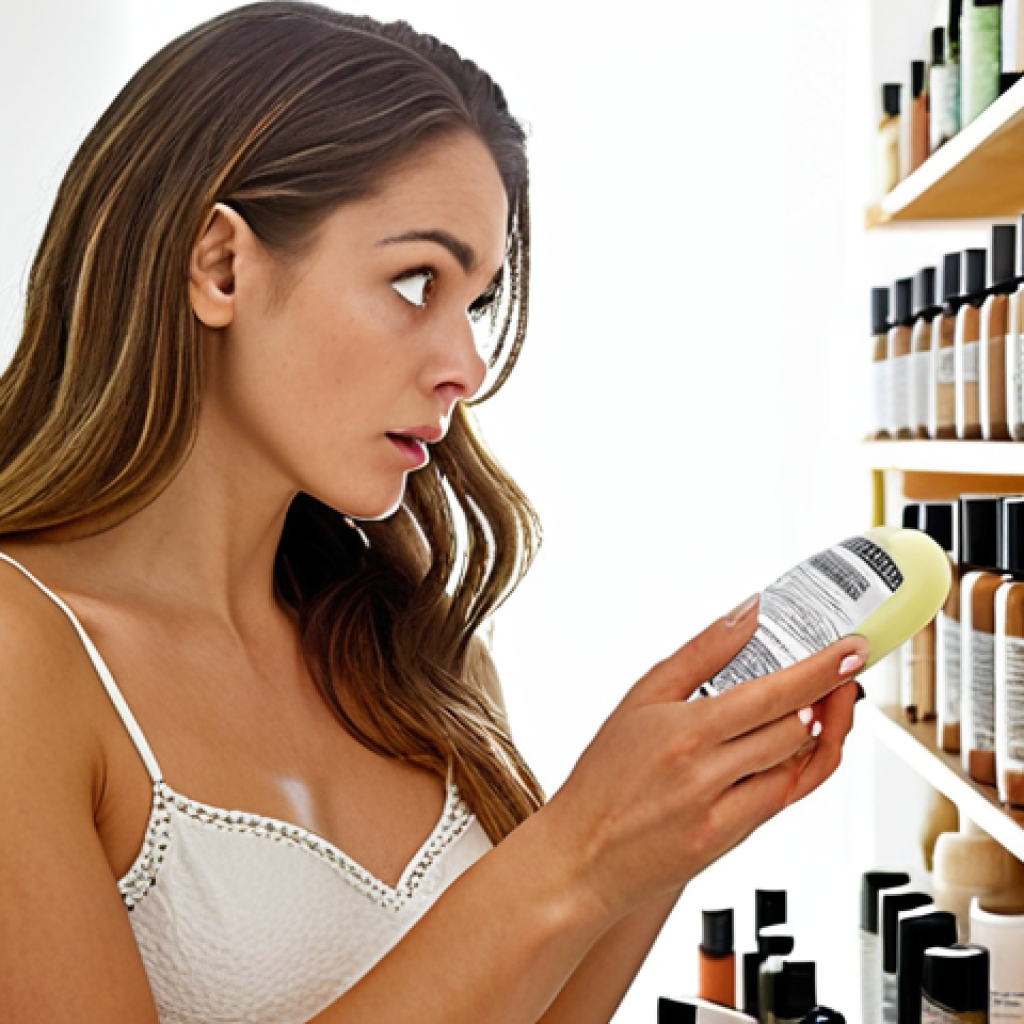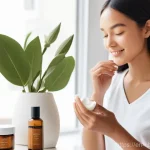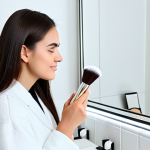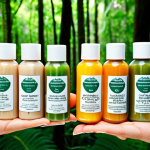Have you ever wondered what really sets natural and herbal cosmetics apart? It’s more than just a label – it’s about the ingredients and their origins.
Natural cosmetics often boast plant-derived components, while herbal cosmetics tap into traditional medicine using specific herbs known for their therapeutic effects.
I’ve noticed that many brands are now focusing on sustainably sourced ingredients and eco-friendly packaging, reflecting a growing consumer demand for transparency and ethical practices.
Interestingly, the rise of personalized skincare, driven by AI and data analysis, is leading to a greater focus on understanding how these natural and herbal ingredients interact with individual skin types.
Let’s delve deeper and unravel the differences together!
Decoding the Labels: What’s Really in Your Natural Beauty Products
Navigating the beauty aisle can feel like deciphering a secret code, especially when it comes to “natural” cosmetics. I remember one time I was searching for a new moisturizer and was bombarded with labels screaming ‘organic,’ ‘natural,’ ‘eco-friendly.’ It was overwhelming!
The reality is, the term “natural” isn’t strictly regulated, so brands have quite a bit of leeway. This is why it’s super important to become a savvy label reader.
Understanding the Ingredient List
When I pick up a product, the first thing I do is flip it over and scan the ingredient list. Generally, natural cosmetics will feature a higher concentration of plant-derived ingredients like aloe vera, shea butter, jojoba oil, and various botanical extracts.
These are often listed first, indicating their prominence in the formula. It’s also a good sign if you recognize most of the ingredients. However, don’t be fooled; even products labeled “natural” can contain synthetic preservatives to extend shelf life, or artificial fragrances.
So, doing a little research on unfamiliar ingredients can be incredibly helpful.
Certifications: A Helpful Guide
To add another layer of complexity, many certifying bodies offer stamps of approval for natural and organic cosmetics. Look out for certifications like COSMOS, Ecocert, or the USDA Organic seal.
While not perfect, these certifications generally mean the product has undergone independent testing to verify its ingredients and manufacturing processes meet certain standards.
I’ve found that these certifications provide a little extra peace of mind when I’m trying a new product. They offer an additional layer of scrutiny, making it a bit easier to trust the claims.
Beyond the Bottle: Ethical Considerations
For me, “natural” beauty goes beyond just what’s inside the bottle. It’s also about ethical considerations like sustainable sourcing, fair trade practices, and cruelty-free testing.
Many natural beauty brands are committed to transparency, detailing where their ingredients come from and how they’re processed. Cruelty-free certifications like Leaping Bunny indicate that the product wasn’t tested on animals, which is a big plus in my book.
I always try to support brands that prioritize ethical and sustainable practices because it makes me feel good about my purchase.
Unlocking Ancient Secrets: The Power of Herbal Ingredients in Skincare
Herbal cosmetics are like a fascinating journey back in time, incorporating botanical extracts and traditional medicinal knowledge passed down through generations.
I find it incredibly intriguing that certain herbs, like chamomile and calendula, have been used for centuries to soothe and heal the skin. The difference with herbal cosmetics lies in their intentional use of these ingredients for their therapeutic properties, often following traditional herbalism principles.
Traditional Remedies, Modern Formulations
Herbal skincare leverages the potent properties of plants known for their medicinal benefits. Ingredients like ginseng, known for its anti-aging properties, or turmeric, recognized for its anti-inflammatory and brightening effects, are common.
What’s really cool is that modern science is increasingly validating the traditional uses of these herbs, revealing the mechanisms behind their effectiveness.
I recently read a study that showed how compounds in green tea can protect skin from UV damage – it’s amazing how ancient wisdom aligns with modern research!
Sourcing and Preparation Methods
The quality of herbal cosmetics hinges on how the herbs are sourced and prepared. Many herbalists emphasize the importance of wild-harvesting or organically growing herbs to ensure they are free from pesticides and contaminants.
The extraction method also plays a crucial role; some methods, like cold pressing or maceration, help preserve the delicate compounds in the herbs. I always try to find brands that are transparent about their sourcing and preparation methods because it indicates their commitment to quality.
Potential Benefits and Considerations
Herbal cosmetics can offer a range of benefits, from soothing irritated skin to reducing inflammation and promoting overall skin health. However, because herbal ingredients are often highly potent, it’s important to patch-test new products to check for any allergic reactions.
I’ve personally found that some herbal products, like those containing tea tree oil, can be quite effective for treating blemishes, but it’s always best to start with a small amount to see how your skin reacts.
It’s also worth noting that herbal remedies can interact with certain medications, so it’s always a good idea to consult with a healthcare professional if you have any concerns.
The Science Behind the Soothing: How Natural Ingredients Calm Irritated Skin
Ever wondered why that chamomile tea bag seems to magically soothe your puffy eyes? It’s because natural ingredients often possess inherent anti-inflammatory and calming properties.
I’ve personally experimented with various natural remedies for my sensitive skin, and I’ve been consistently impressed by their gentle yet effective results.
Chamomile and Calendula: Nature’s Gentle Healers
Chamomile and calendula are two powerhouse ingredients known for their soothing and anti-inflammatory benefits. Chamomile contains compounds like bisabolol, which helps calm irritated skin and reduce redness.
Calendula, on the other hand, is rich in antioxidants and has wound-healing properties. I’ve used chamomile-infused serums to soothe sunburned skin and calendula balms to heal minor cuts and scrapes – they’re truly nature’s gentle healers!
Aloe Vera: The Hydration Hero
Aloe vera is a staple in natural skincare for its incredible hydrating and soothing abilities. It’s packed with vitamins, minerals, and amino acids that help moisturize the skin and promote healing.
I always keep a bottle of pure aloe vera gel on hand for soothing sunburns, calming irritated skin after shaving, and even as a light moisturizer during the summer months.
The cooling sensation of aloe vera is just so refreshing and calming!
Oat Extracts: The Itch Reliever
Oat extracts, like colloidal oatmeal, are fantastic for relieving itchiness and irritation. They create a protective barrier on the skin, helping to lock in moisture and prevent further irritation.
I’ve recommended oat-based creams to friends with eczema and dry skin, and they’ve all raved about how effectively they relieve itching and soothe inflammation.
If you struggle with sensitive or easily irritated skin, oat extracts might just be your new best friend.
The Antioxidant Advantage: Natural Ingredients That Fight Aging
One of the most compelling benefits of natural cosmetics is their rich supply of antioxidants. These compounds help protect your skin from free radical damage, which is a major contributor to premature aging.
I remember learning about antioxidants in a biology class and thinking, “Wow, this is like a superpower for my skin!” And it’s true – incorporating antioxidant-rich ingredients into your skincare routine can make a noticeable difference in the long run.
Green Tea: The Antioxidant Powerhouse
Green tea is a true antioxidant powerhouse, packed with polyphenols that help neutralize free radicals and protect the skin from UV damage. I’ve noticed a visible improvement in my skin’s texture and brightness since I started using green tea-infused serums and creams.
It’s like giving my skin a shield against the daily onslaught of environmental stressors.
Vitamin C: The Brightening Booster
Vitamin C is another superstar antioxidant that brightens the skin, boosts collagen production, and protects against sun damage. I love using vitamin C serums in the morning to give my skin a radiant glow and extra layer of protection.
Just make sure to choose a stable form of vitamin C and store your serum in a dark, airtight bottle to prevent oxidation.
Berry Extracts: Nature’s Sweet Treat for Your Skin
Berry extracts, like blueberry, raspberry, and cranberry, are bursting with antioxidants and vitamins that nourish and protect the skin. They also have anti-inflammatory properties, making them great for soothing irritated skin.
I enjoy using berry-infused masks and scrubs to give my skin a healthy, youthful boost. It’s like treating my skin to a delicious and nutritious smoothie!
Navigating the “Greenwashing” Trap: How to Spot Authentic Natural Brands
With the growing popularity of natural cosmetics, it’s easy to fall victim to “greenwashing” – misleading marketing tactics that make a product seem more natural than it really is.
I’ve definitely been duped by clever marketing ploys in the past, so I’ve learned to be extra cautious and do my research before buying a product.
Decoding the Labels: Look Beyond the Buzzwords
Don’t just rely on labels like “natural” or “eco-friendly.” Instead, scrutinize the ingredient list and look for certifications from reputable organizations like COSMOS or Ecocert.
Also, pay attention to the order of ingredients – the ingredients listed first are present in higher concentrations.
Research the Brand: Transparency is Key
Authentic natural brands are transparent about their sourcing, manufacturing processes, and ethical practices. Check their website for detailed information about their ingredients, certifications, and commitment to sustainability.
If a brand is vague or evasive, it’s a red flag.
Read Reviews: Learn from Other Consumers
Before trying a new product, read reviews from other consumers to get an honest assessment of its effectiveness and authenticity. Look for reviews that specifically mention the product’s natural ingredients and whether it lived up to its claims.
Crafting Your Own Natural Beauty Recipes: DIY Skincare
One of the most rewarding ways to ensure you’re using truly natural cosmetics is to make your own! DIY skincare allows you to control every ingredient and customize recipes to suit your specific skin needs.
I’ve experimented with countless DIY recipes over the years, and it’s been such a fun and empowering way to connect with nature and nourish my skin.
Simple DIY Face Mask: Honey and Oatmeal
This simple face mask is perfect for soothing irritated skin and reducing inflammation. Just mix together 1 tablespoon of honey, 1 tablespoon of finely ground oatmeal, and a few drops of water to form a paste.
Apply to your face, let it sit for 10-15 minutes, and then rinse with warm water.
DIY Exfoliating Scrub: Sugar and Coconut Oil
This gentle exfoliating scrub removes dead skin cells and leaves your skin feeling smooth and radiant. Mix together 1 tablespoon of sugar (brown or white), 1 tablespoon of coconut oil, and a drop of your favorite essential oil (like lavender or tea tree).
Gently massage onto your skin in circular motions, then rinse with warm water.
DIY Hair Mask: Avocado and Olive Oil
This nourishing hair mask deeply conditions dry and damaged hair. Mash half an avocado and mix it with 1 tablespoon of olive oil. Apply to your hair, focusing on the ends, and let it sit for 20-30 minutes.
Then, rinse with shampoo and conditioner.
Future Trends: The Evolution of Natural and Herbal Cosmetics
The natural and herbal cosmetics industry is constantly evolving, driven by innovation, scientific discoveries, and growing consumer demand for sustainable and ethical products.
I’m excited to see what the future holds for this dynamic field!
Personalized Skincare: Tailored to Your Unique Needs
Personalized skincare is becoming increasingly popular, with brands using AI and data analysis to create custom formulas based on individual skin types and concerns.
This allows for more targeted and effective treatments using natural and herbal ingredients.
Sustainable Packaging: Reducing Environmental Impact
Sustainable packaging is a major focus for many natural beauty brands, with companies exploring innovative alternatives to traditional plastic packaging.
Look for products packaged in glass, aluminum, biodegradable materials, or refillable containers.
Biotechnology: Harnessing Nature’s Power with Science
Biotechnology is playing an increasingly important role in the development of natural cosmetics, with scientists using fermentation and other processes to extract and enhance the benefits of natural ingredients.
This allows for the creation of more potent and effective natural skincare products. Here’s a table summarizing the key differences between natural and herbal cosmetics:

Decoding the world of natural and herbal cosmetics can feel like a real adventure, but armed with the right knowledge, you can make informed choices that benefit both your skin and the planet.
Remember to read labels carefully, research brands, and don’t be afraid to experiment with DIY recipes to find what works best for you. Embrace the journey towards healthier, more radiant skin – naturally!
In Conclusion
Exploring the world of natural and herbal cosmetics opens doors to healthier skin and sustainable choices. By being informed consumers, we can support brands committed to transparency and quality. Remember, the best products are those that nourish your skin and align with your values. Here’s to a more radiant you, naturally!
Good to Know Info
1. Patch Test is Key: Before fully incorporating a new product into your routine, always perform a patch test on a small area of skin to check for any adverse reactions.
2. Storage Matters: Store your natural and herbal cosmetics in a cool, dark place to prevent oxidation and maintain their efficacy. Avoid direct sunlight and extreme temperatures.
3. Expiration Dates Exist: Natural products may have shorter shelf lives than conventional cosmetics due to the absence of harsh preservatives. Pay attention to expiration dates and discard products that have expired.
4. DIY with Caution: When creating your own skincare recipes, ensure that you use high-quality, food-grade ingredients to avoid contamination or irritation. Always research the properties of each ingredient before incorporating it into your formulations.
5. Consult a Professional: If you have specific skin concerns or underlying health conditions, consult with a dermatologist or qualified herbalist before making significant changes to your skincare routine.
Key Takeaways
Ingredient Awareness: Learn to identify common synthetic ingredients and prioritize products with plant-derived alternatives.
Certification Matters: Look for certifications from reputable organizations to verify the authenticity and quality of natural and organic cosmetics.
Ethical Considerations: Support brands that prioritize sustainable sourcing, fair trade practices, and cruelty-free testing.
DIY Possibilities: Explore the world of DIY skincare to control every ingredient and customize recipes to suit your specific skin needs.
Embrace the Journey: Experiment, learn, and find what works best for you to unlock the full potential of natural and herbal cosmetics.
Frequently Asked Questions (FAQ) 📖
Q: So, if I’m seeing “natural” and “herbal” thrown around on all sorts of products, how can I really tell if they’re the real deal? It’s not like they’re always upfront about where things come from, right?
A: You’re spot on – it can be tricky! I’ve found that digging a bit deeper than the marketing buzzwords is key. Check the ingredient list thoroughly; look for recognizable plant names and avoid long lists of unpronounceable chemicals.
Certifications from organizations like ECOCERT or the USDA Organic seal can also be helpful, as they indicate that a product has met certain standards for natural or organic ingredients.
But even those aren’t foolproof, so I often cross-reference the brand with independent reviews and check if they’re transparent about their sourcing practices on their website.
If they’re cagey about where ingredients come from, that’s usually a red flag for me. And honestly, after using several products, my skin can tell the difference – some “natural” products still cause reactions while others feel genuinely nourishing.
Q: Okay, but what about my sensitive skin? I swear, everything breaks me out.
A: re natural and herbal cosmetics actually better for that, or is it just wishful thinking? A2: As someone who’s battled sensitive skin myself, I get your skepticism!
While natural and herbal formulations can be gentler, it’s not a guarantee. “Natural” doesn’t automatically mean “hypoallergenic.” In fact, some natural ingredients, like certain essential oils or fragrances, can be major irritants for sensitive skin.
What I’ve learned is to patch-test everything before slathering it all over my face. Look for products specifically formulated for sensitive skin, often labeled “fragrance-free” or “non-comedogenic.” Ingredients like chamomile, aloe vera, and calendula are generally soothing and well-tolerated.
Honestly, though, finding the right product often involves a bit of trial and error, and keeping a journal to track what works and what doesn’t can be a lifesaver.
Q: This personalized skincare thing sounds cool, but also a little…creepy? How does knowing my skin type through
A: I really help when it comes to picking natural or herbal stuff? A3: I totally see your point about the “creepy” factor! But I think of it like this: AI-powered skincare analysis is just giving you a more in-depth understanding of your skin’s unique needs.
It’s not replacing your intuition, but complementing it. For example, an AI analysis might reveal that you have a specific type of dryness or a sensitivity to certain plant extracts that you weren’t aware of.
That information can then guide you towards natural or herbal products that are specifically formulated to address those concerns. Personally, I’ve used online skin analysis tools that helped me realize my skin was more prone to redness than I thought.
This led me to try products with green tea and niacinamide, which have made a visible difference. The key is to use that data as a starting point and continue to listen to your skin’s signals and adjust your routine accordingly.
📚 References
Wikipedia Encyclopedia
구글 검색 결과
구글 검색 결과
구글 검색 결과






